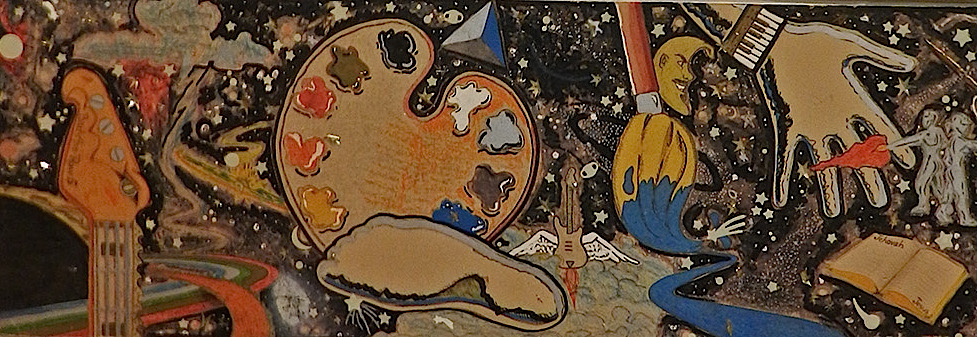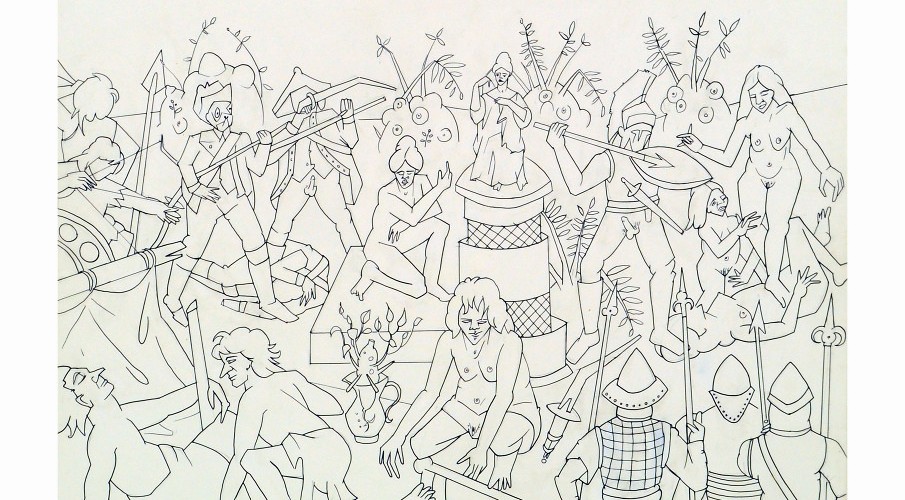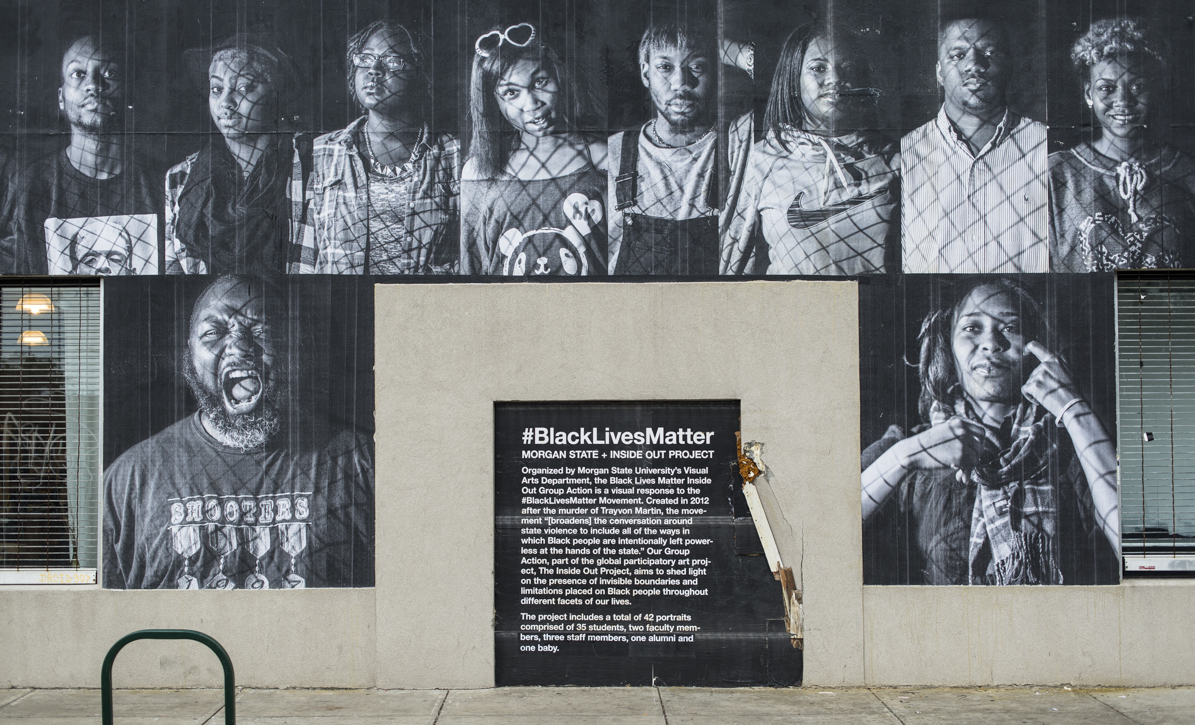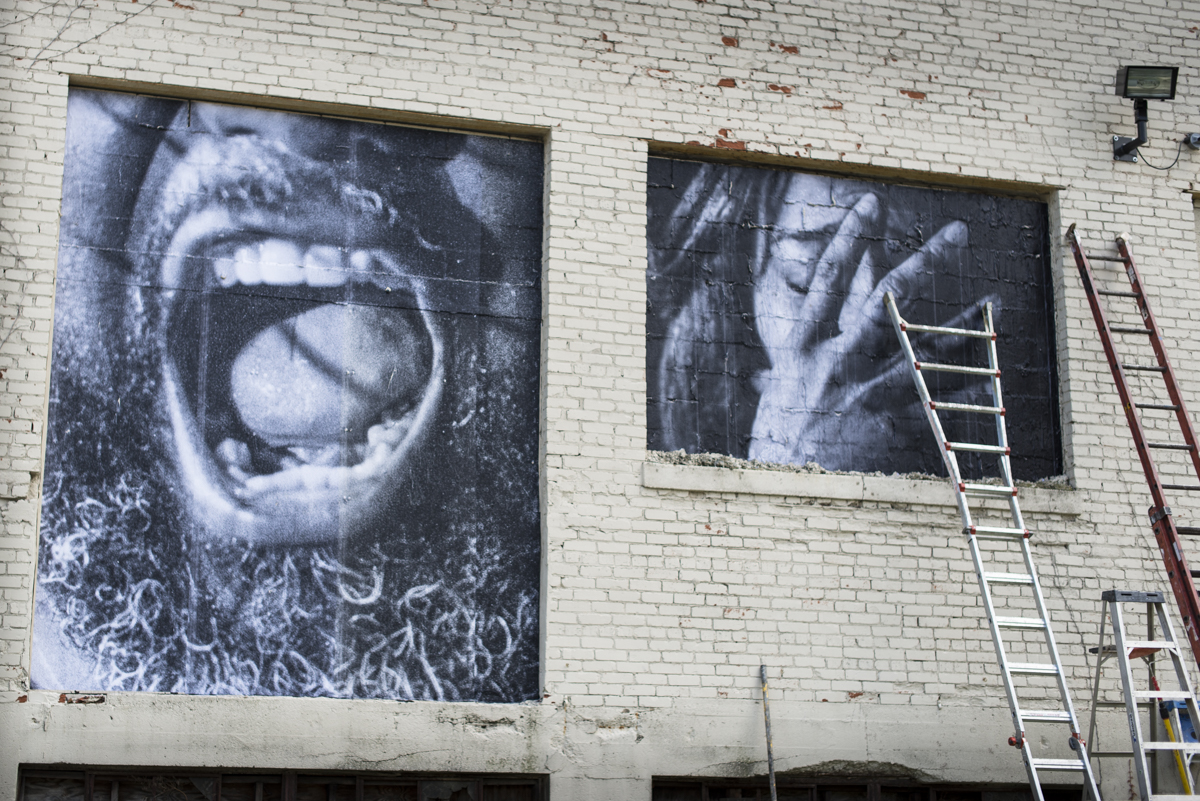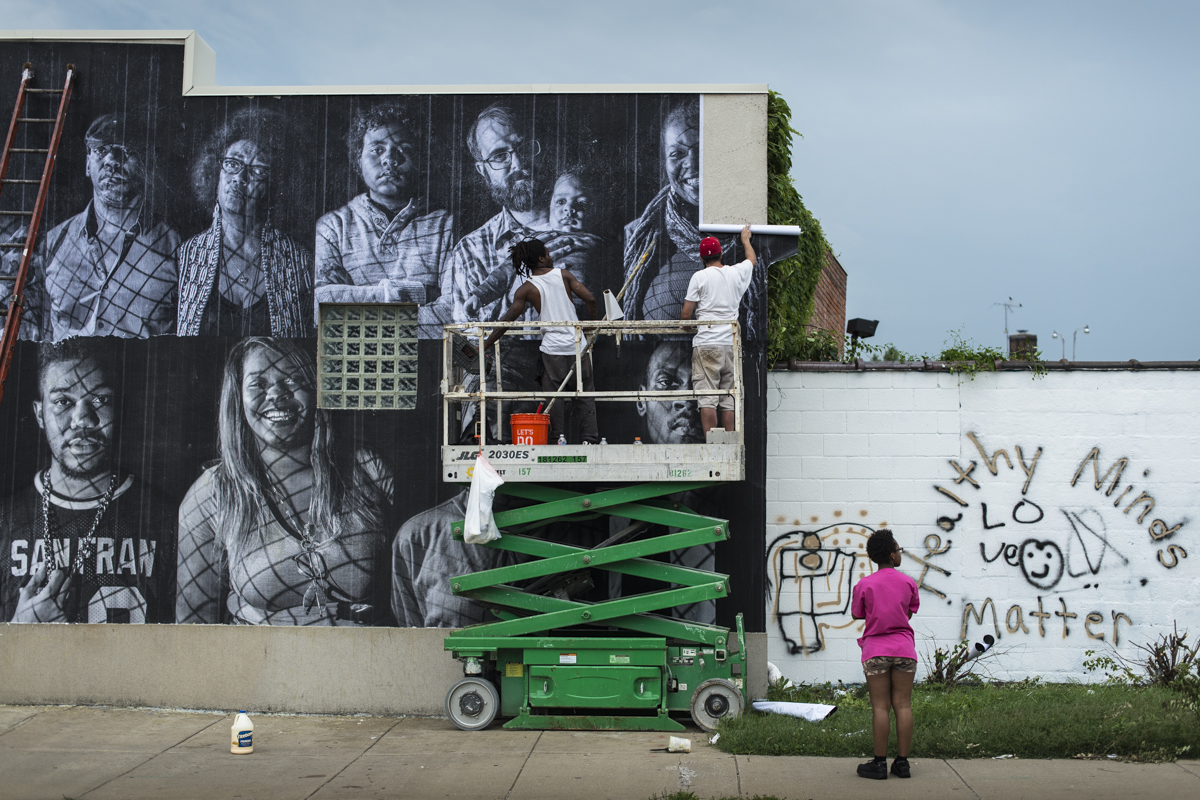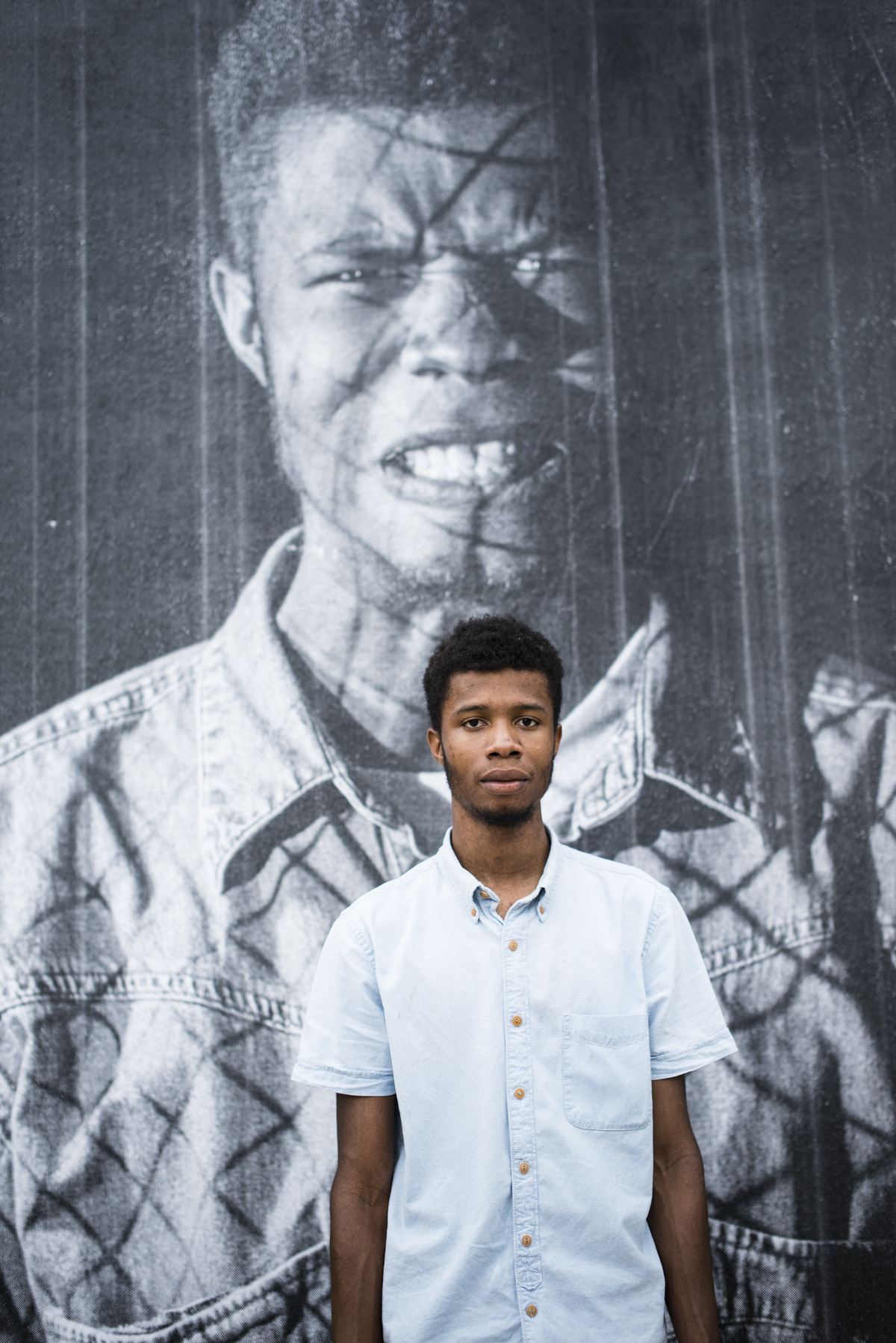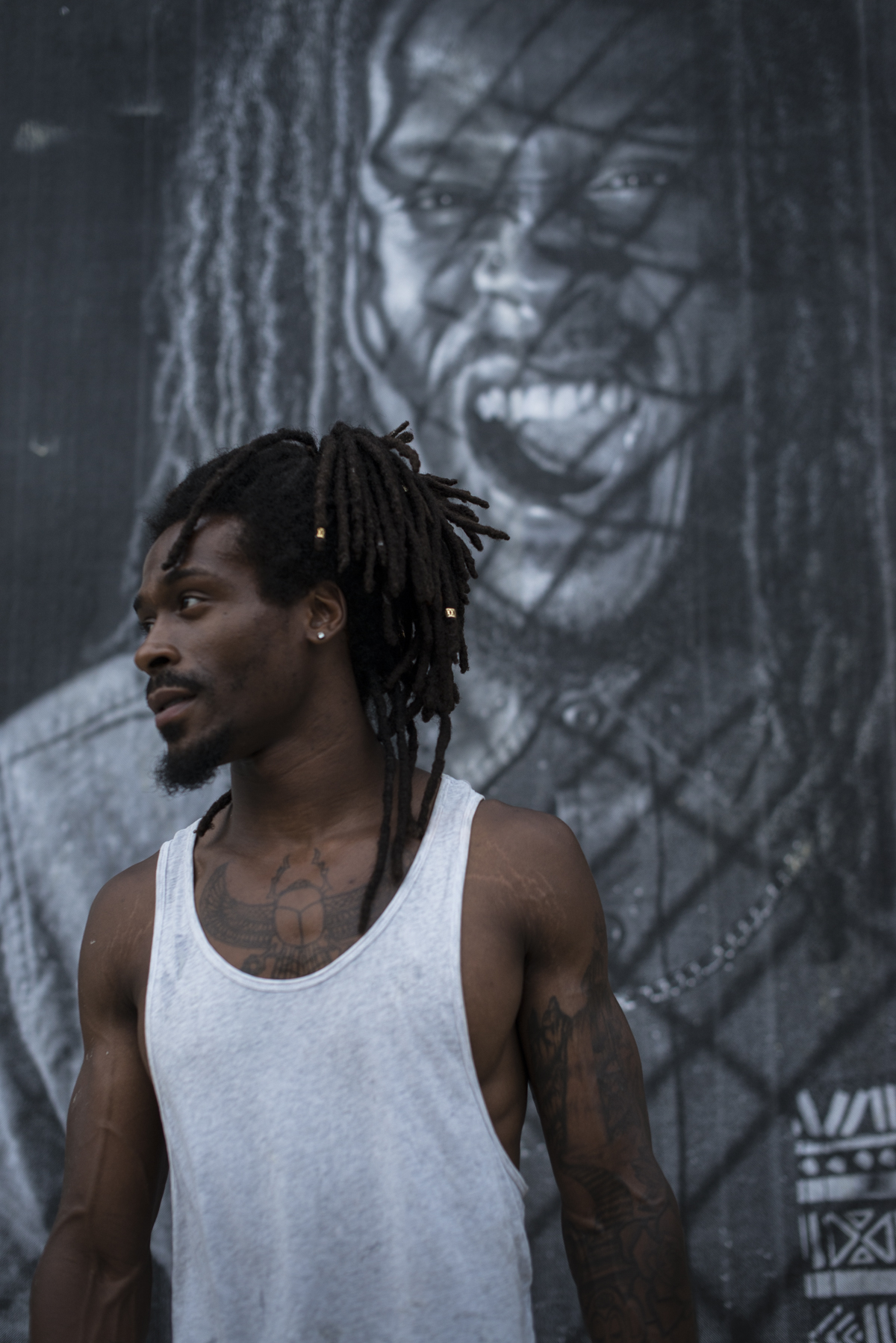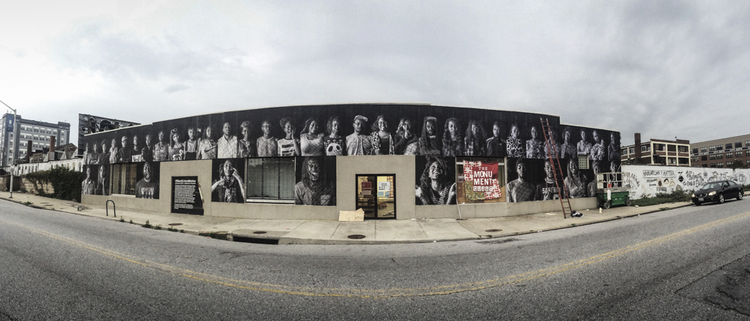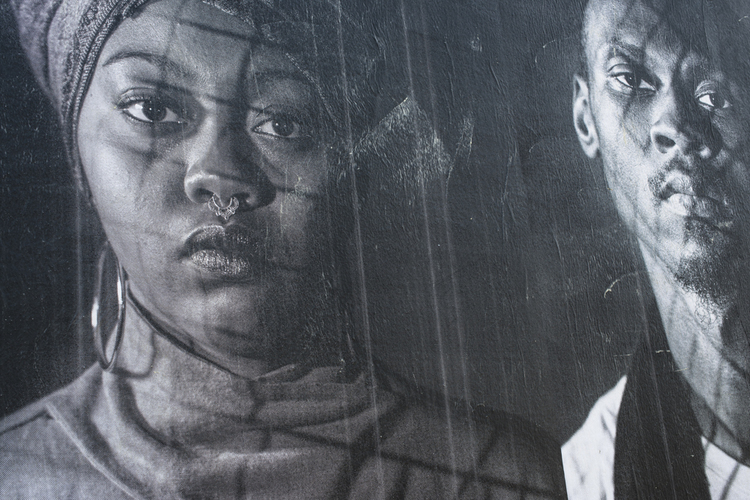The “Inside Outside – Black Lives Matter” Mural in Baltimore by Cara Ober
Christopher Metzger, a visual artist and professor at Morgan State University, urged his design students to consider current events playing out in Baltimore and across the country. What they achieved together is “Inside Outside – Black Lives Matter,” a highly successful site specific installation in Baltimore that has been covered by press across the country.
The mural depicts forty-two giant portraits of black artists and activists, all wheat pasted into a new maker space called Open Works, located at 1400 Greenmount Avenue. The building is located in the Station North Arts and Entertainment District and is slated to become a 3D Digital Incubator space in 2016. The faces are frontal and stare out from the building in pride and solidarity, a visual response to the Black Lives Matter movement.
After viewing a documentary with his students about street artist JR’s Inside Out project, which places massive portraits of marginalized residents in communities around the world, Metzger’s class decided to create a response in a similar fashion. Their addition to the design was to add a shadow of a chain link face across the faces of each individual to symbolize the “boundaries and limitations placed on Black people throughout different faces of our lives,” said Metzger on his website.
Together, with former student Kelli Williams, Metzger organized the project. The following is a transcript from our conversation.
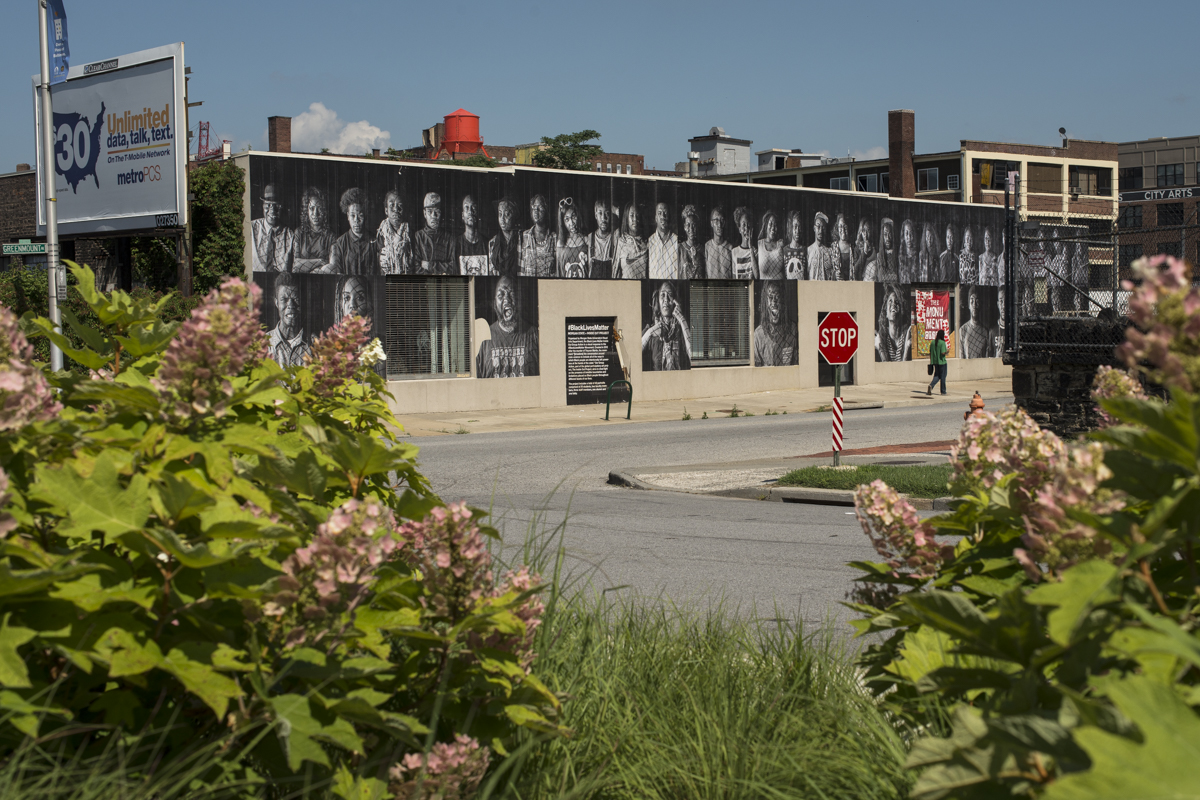
BmoreArt: Can you talk about how this project came about?
Chris Metzger: A former student who has worked with me for the past four years, Kelli Williams, and I have been discussing the possibility of facilitating an Inside Out group action for a few years now. JR is an artist I teach about in class, and in regards to one course, specifically to speak to the power of social media to bring awareness to causes around the world.
We study artists, musicians, and a range of individuals who have used technology and social media to bring about positive change in a number of different ways. Beyond what we were learning in class, the timing just felt right. JR released a documentary that focused on a number of group actions around the world and I shared this documentary with my students prior to their engagement in the project. We then began the proposal phase where each student proposed a topic for our group action. From there we narrowed down our options, eventually settling on the Black Lives Matter theme.
BmoreArt: How did it evolve into something physical?
Chris: Once the theme was chosen, my advanced computer graphics class was responsible for providing the visuals to match the message. We studied portraiture, researched other Inside Out group actions, and they had to present Kelli and I with options for approval. Essentially, we facilitated the project and critiqued each stage as my students progressed through the process. Once we approved a final vision for the portraits, a group or 4-5 students shot all 42 portraits before Kelli and I finalized the work and prepped it for printing.
We made the site visits and came up with a mock-up based on my students concepts and visuals, collaborating throughout the entirety of the project. The initial goal was to complete installation during the semester, but we ran out of time and had to push the install back date to allow enough time for printing and site preparation. With that said, my students came through and have been helping with the installation from the beginning, even though the semester is over and they’re all working jobs.
BmoreArt: As a professor at Morgan State University, what is the impact that you have observed of the BlackLivesMatter movement? What does this mean for you and your students? How do is this changing their personal or political identities?
Chris: Honestly, it’s difficult to say specifically. I’ve noticed a call to action over the last few years and a greater awareness of events unfolding around us, but I’m not sure you can attribute that entirely to the BlackLivesMatter movement. The movement to me is more of a branding of something people have been doing for years. People have been protesting for a long time, but I think with social media and the sharing of images and video, the movement has become more visible and widespread. People are able to mobilize quickly and organize marches or protests. We no longer read about a police officer killing an unarmed Black man, we can actually watch it on our phones.
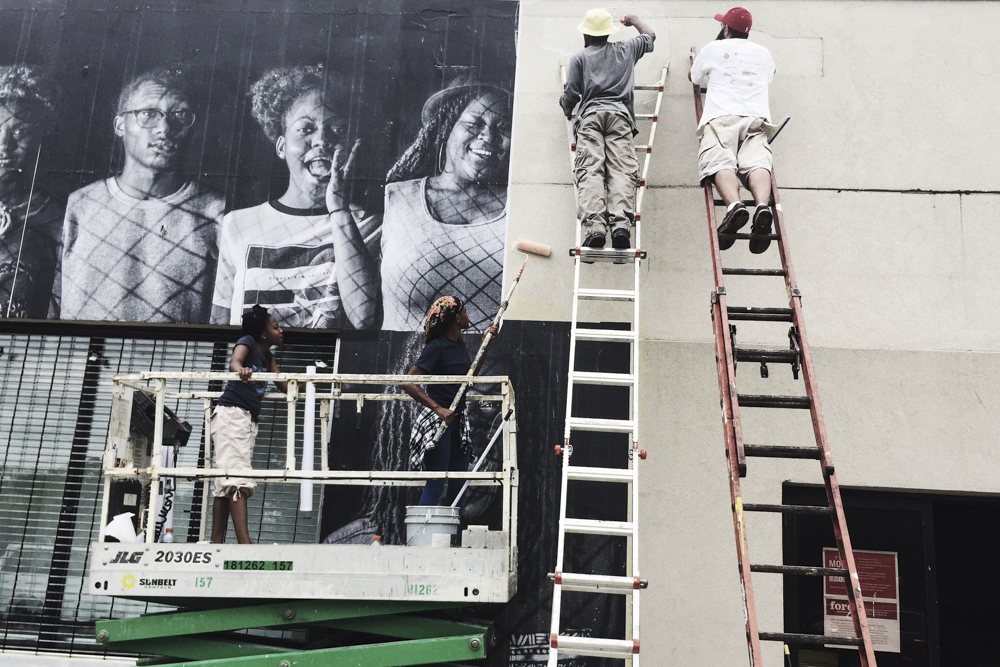
I think this immediacy and access is important to the movement. You saw this happen with the uprising here in Baltimore. We were actually able to see contradicting views of the same event happen before our eyes, immediately. I don’t think you can see these images and videos and not change your personal and political identities. Whether it’s the BlackLivesMatter movement, or another movement, it’s great to see students realizing that they have the power to effect change locally in their communities, as well as on a larger scale nationally and perhaps internationally.
Kelli: Since the start of the #BlackLivesMatter movement I have noticed an increase in students awareness of social and political issues. I have noticed more conversations and debates about social justice. I feel that the creation of the hashtag has given students power in a sense, a feeling that anyone can create change. Even before the uprising, students felt it was necessary to add to the #BlackLivesMatter movement. College students, especially at historically black institutions, have played a major role in this movement through social media and through organizing rally’s and group actions. With the click of a button you can organize a rally or a group clean up and many of our students have. During the “Baltimore Uprising” Morgan State played a major role in the community. Students organized a clean up on the areas affected by the riot, organized marches, and created protest art.
BmoreArt: How did you decide on a format for this mural?
Chris: The medium was decided by our participation in the Inside Out Project. JR, the artist who initiated the project after he won the Ted Prize in 2011, uses wheat pasting as his primary medium, as do the participants in the project. This was our first time wheat pasting, so we talked to a few people and conducted a few tests prior to installation. The format of the piece came about through our partnership with BARCO and the future site of Open Works, a makerspace / incubator lab that will occupy the building we pasted on. Once we were given access to the site, Kelli and I mocked up the design a number of different ways, settling on the design we ultimately thought would have the most visible impact.
BmoreArt: Can you talk about the media and materials that went into it? How were images made and then combined and adhered?
Chris: The images are rolls on engineering prints that we adhere to the wall like wallpaper, creating a seamless appearance to the overall piece. For the most part, the images have been adhering to the wall with a mixture of wheat paste and wallpaper adhesive, although I have to admit, the weather has not been our friend the last few weeks, as we recently lost a few pieces due to the heavy wind and rain. The deterioration is part of the piece though, so we’re slowly learning to accept that part of the process.
The format of large scale wheat pastings is ideal for our message because this is a public conversation we need to be having in America. It’s incredibly relevant, and regardless of race, we need to deal with these issues out in the open and stop pretending like they don’t exist or we’ve moved past them. During the time we proposed, conceptualized, and executed the project, Freddie Gray died while in police custody, protests erupted in Baltimore, and most recently, on our first day of installation, nine people were murdered in Charleston in a racially motivated terrorist attack. So, it’s our hope that a public piece of this scale helps to spark these conversations, and whether we agree or disagree, we’re at least opening up a dialogue regarding race relations here in America.
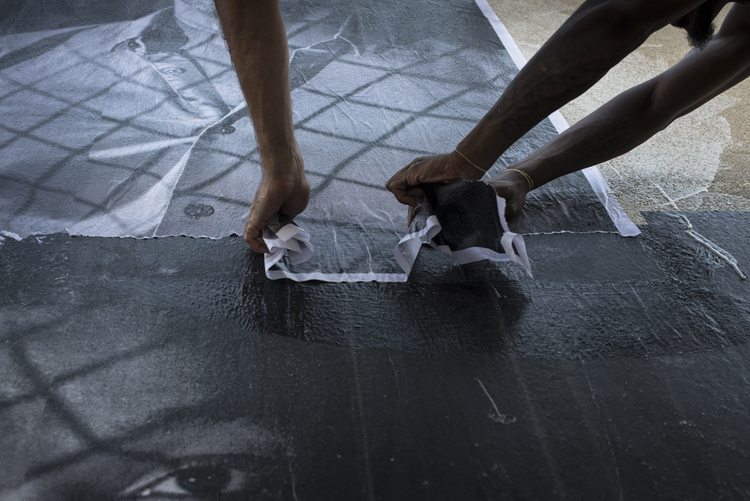
BmoreArt: How did you find a location?
Chris: The original relationship began with my mentor, the amazing Leslie King-Hammond. Ever since grad school she’s given me advice, told to to rethink my ideas, and challenged me as an artist. The location came about through her relationship with the Deutsch Foundation and BARCO. They are developing a number of artist spaces in the area, so Leslie presented our proposal to the committee and we received approval. Will Holman has also been a great help in allowing us access to the space and assisting with any questions or concerns we’ve had throughout the duration of the project. There is no building staff currently, as they are set to begin renovation in August/September.
BmoreArt: Why did this spot seem appropriate and how has the relationship with the building staff evolved?
Chris: The site seemed appropriate because of it’s proximity to both Station North and the Johnston Square Neighborhood. We all felt that the piece would support the mission of the future Open Works site, which is to engage the local community, as well as artists. Since we began the installation, we’ve had a number of community members ask about what the building will be used for in the future, so having those conversations now can be incredibly beneficial to everyone involved. The site itself gets a lot of foot and car traffic, so visibility was important to us as well. It wasn’t our original plan to install across from a cemetery, but you could even argue that the proximity to this area indirectly speaks to our message – the loss of Black lives.
BmoreArt: Who are the students who participated in the project?
In total, we had 42 participants – 35 students, 3 staff members, 2 faculty members, an alumni and a baby (my 8 month old son.) This has been a collaborative project from the start.

CO: What has been the student and public reaction to the project?
Chris: The student reaction has been great. I think it’s difficult for students to envision artwork that might be 3 or 4 months from creation/completion, but now that the piece is up, I think everyone is really excited about it and the impact it’s having not only in the community, but by everyone passing by or coming to visit the piece. My installation team is probably tired of me texting them to set up install dates because we’ve been working incredibly hard, but I think that only adds to the value of the piece. The project hasn’t been easy, the subject matter we’re dealing with is not always easy to discuss, but the potential impact art can have on opening up dialogue and engaging people in conversations surrounding these issues is amazing.
Chris: The public response has been overwhelmingly positive too. We’ve had a number of people from the community walk by and express their interest in the project. We’ve also had a lot of people pull their cars over and take pictures, get out and talk to us, as well as honk while driving by, so that has been great for myself, but especially my students. About 10 students have been assisting with the installation and it’s amazing to receive feedback from people passing by while we’re installing the piece.
One woman actually stopped traffic to carry on a conversation with us and you could tell by the look in her eyes that she was grateful to see the work being put up. Another gentleman provided a brief history of the building and said he always wondered what would happen after the original occupants left (a thrift store that had been broken in to on three occasions) and was pleased to see something like this taking place. Unfortunately, I’m often 20 feet up on a ladder, but my students are the ones who’ve heard a majority of the responses.
We were doing some repair today after the most recent rain and wind storm and some people were worried that we were taking down the piece, which we are definitely not doing. We’ve also come to recognize familiar faces and it’s nice hearing their response as the piece has evolved throughout the installation.
BmoreArt: Will there be more projects in this series?
Chris: There will always be more projects, although I never thought of this project as a series. I’m open to it though. I try to engage my students in as many of my projects as possible, so there’s always a certain level of collaboration in my personal work and the material I teach in the classroom. I also believe strongly in creating work that has a message. I studied under artists who valued the message behind the work and this has always stuck with me as an artist and educator, so it’s something that inevitably finds it’s way into my curriculum. We’ll just have to see where this takes us.
BmoreArt: What are you looking to do next?
Chris: As for what I’m looking to do next, I’m already doing it. Each summer, I teach art to middle school students at a local non profit called Bridges. That will occupy the next month or so of my calendar and I’m always balancing multiple projects, usually design and fine art. I’m also looking to develop an Artist Exchange Program at Morgan State University, where I’ve taught for the last 6 years. I’d like to provide my students with more opportunities like this project, but with a more diverse selection of artists. As for personal work, we’ll see. There’s a few bodies of work waiting to get started and after this experience, I’m very interested in creating more public art on a larger scale.
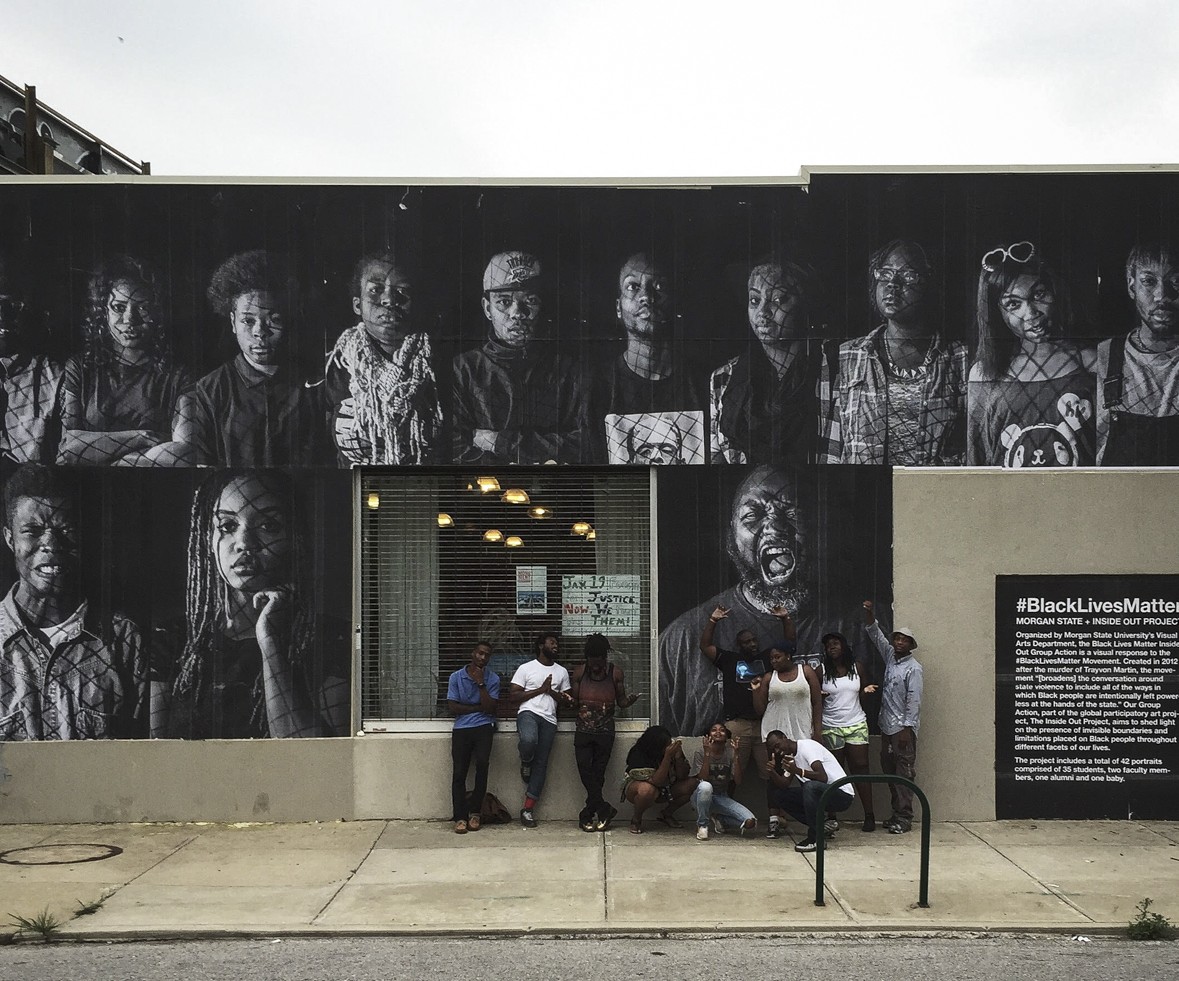
Kelli: The student and public reaction has been amazing. While installing the piece, community members have been stopping to take pictures, asking questions, and giving compliments on the piece. A group of young people also stopped and asked if we could put them on the building. On social media we have also gotten great feed back. There has been many people re-posting and adding positive comments on articles about the piece. We even got an email from the Inside Out crew congratulating us. There was a small group of students who helped us install the project. They seem to really have a connection to the project and are proud that they got to be a part of it. They seemed to be particularly impressed by the communities reaction. It makes all of us feel that all of the long hours were worth it.
Chris: We never considered this project as a series but we are working on finding a permanent location for the installation. We hope that this project can lead to even more opportunities for our students. We have a stockpile of ideas that include traveling abroad, visiting artists, and more collaborative projects.
Author Cara Ober is Founding Editor at BmoreArt.
Photos by Chris Metzger and Kelli Williams
